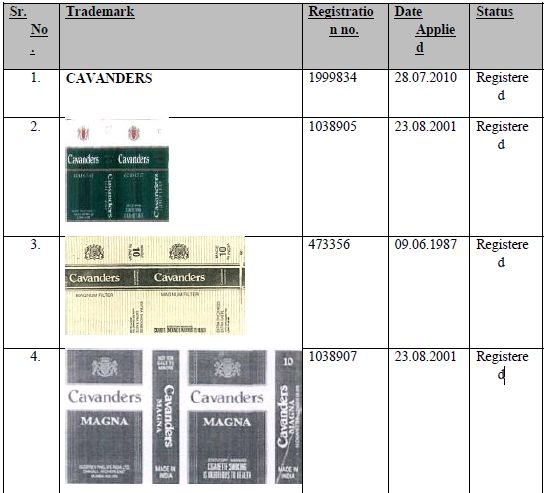In a recent case dismissed by the Delhi High Court, tobacco manufacturer Godfrey Phillips' contention of passing off against defendant PTI Private Limited was termed an attempt at monopolization of the market. The age old question of passing off and usage of partial aspects of registered trademarks was raised again, where the proprietor was held to have been granted a complete mark, but not the rights to police those who used partial aspects of it.
Brief Background:
- Plaintiff in this case is Godfrey Philips India Ltd., a flagship company of the Modi Enterprises and is one of India's largest cigarettes manufacturers, responsible for brands such as Four Square, Red & White and Cavanders – the latter of which is the brand embroiled in this matter.
- The Defendant No.1 is P.T.I. (Private) Limited, another company which manufacture cigarettes by the name of "FUN GOLD" with the suffix "SUPER LEAF'.
- The Plaintiff in question had filed for a permanent injunction in an attempt to restrain the Defendant and any in his employment from manufacturing and selling the aforementioned cigarettes, along with a rendition of accounts of profits that have been "illegally" earned by the Defendant by using a deceptively similar mark/label.
- The Plaintiff claims to be the registered owner of the mark "CAVANDERS" in a green and gold packaging with the expression "GOLD LEAF", under whose name the Plaintiff conducts a sale of cigarettes. The Defendants on the other hand, sell a brand of cigarettes using the expression "FUN GOLD", using the expression "SUPER LEAF".
- The main contention here becomes that the Defendants are passing off its goods as those of the Plaintiff on account of its usage of the green and gold color scheme for its packaging, which is a composite of the trademark registration "CAVANDERS" and its label, and thus is claimed by the Plaintiff to be a violation of their intellectual property.
Issue:
Whether the combination of gold and green of the Plaintiff is distinctive enough to be identified with the Plaintiff's brand and thus make usage of the same by the Defendant an act of passing off.
Judgment and Analysis:
The basic contention on behalf of the Plaintiff is that it is the registered proprietor of the trademark in question in two forms, one of which is a wordmark – Cavanders- and the other being the labels/getup of the packaging under which the cigarettes are sold by the Plaintiff. Thus the claim is that such color scheme as has been registered as a part of the label, cannot be used by any other manufacturer of cigarettes including the Defendants who are said to be using the same color scheme. In addition to the cause of action of infringement of the said trademark, the Plaintiff contends that the Defendants are also passing off by way of their usage of the identical green and gold color scheme.
As per our records of the Registry, list of some Registrations of the Plaintiff for the mark "CAVANDERS"


(Compiled by our internal Research Team)
The Court rejected the claim for infringement of the trademark "Cavanders" as it said that the Defendant, who was conducting a trade of cigarettes under the name of "FUN GOLD" accompanied by the suffix "SUPER LEAF" was utilizing a brand/name which was neither identical nor deceptively similar to "CAVANDERS" which is the mark registered under class 34 by the Plaintiff. The Court also took into account Plaintiff's admission that the suit in question was neither for infringement of the trademark labels as a whole, nor for copying of the registered trademark labels of the Plaintiff.
Comparison: Defendant's "FUN GOLD" v Plaintiff's "CAVANDERS"


Rejecting the contention of infringement, the Court moved to deliberate upon whether the Plaintiff is entitled to claim infringement on account of usage by the Defendant of parts of its registered label. It is pertinent to reproduce the provision under Section 17 of the Trade Marks Act, 1999 which reads as under;
17. Effect of registration of parts of a mark.—
When a trade mark consists of several matters, its registration shall confer on the proprietor exclusive right to the use of the trade mark taken as a whole.
(2) Notwithstanding anything contained in sub-section (1), when a trade mark—
- Contains any
part—
- which is not the subject of a separate application by the proprietor for registration as a trade mark; or
- which is not separately registered by the proprietor as a trade mark; or
- contains any matter which is common to the trade or is otherwise of a non-distinctive character, the registration thereof shall not confer any exclusive right in the matter forming only a part of the whole of the trade mark so registered.
On a plain reading of the above section, the Court held that the Plaintiff could not plead infringement with respect to only parts of the registered mark. With regards to the question of passing off, the court held that the combination of gold and green must be held to be distinctive enough that it would be associated only with the trade and goods of the Plaintiff and no other. In this line of thought, the court relied upon the case of Laxmikant V. Patel v. Chetanbhai Shah & Anr. (2003) 3 SCC 65 and further on Oertli v Bowmian (1957 RPC 388) which enumerated upon the requirements to invoke the law on the aspect of distinctiveness. It further emphasized on the fact that unlike the issue of infringement of a trademark, there may be several factors that show that the responsible customer would not be deceived while purchasing goods by thinking that the Defendant's goods are those of the Plaintiff's. Thereby, relying on the aforementioned precedents, the court came to the conclusion that there was no possibility of deception to customers and thus no consequent losses that may be inflicted upon the Plaintiff as a result. Furthermore, since there was no tangential or otherwise connection that may cause the Defendant's cigarettes "FUN GOLD" to be linked with that of the Plaintiff's which is "CAVANDERS" due to a lack of similarity between the two, mere existence of similar color schemes of gold and green would not result in a passing off action.
This case has done a considerable job in enumerating gain the difference between a distinctive mark and the extent to which it can exercise its rights. As has been held in several cases before, one of the being Three-N-Products Private Limited Vs. Emami Limited A.P.O. No. 248 of 2008 in C.S. No. 204 of 2007, the registration of a mark thereof does not convey any exclusive right over the holder, as it is evident by a bare reading of Section 17(2), where the proprietorship of a composite mark does not grant the holder exclusive access over every part or any part of said mark. The judicial principle behind Section 17 allows the exclusive use of the mark as a whole and if a holder desires statutory protection over specific parts of the composite mark, they must specifically register the same while ensuring that it does not contain common terms or non-distinctive characteristics as may be rejected by the Registrar.
Interestingly enough, the matter of infringement stems from unauthorized usage of parts of a trademark that the Plaintiff claims to be a representative of their brand and thus their trade identity. While denying that business conglomerates have often been pegged to use infringement lawsuits to create monopolistic situations, as has been enumerated by the judge in our case at hand, it also begs the question; does anyone have the right to utilize aspects of a registered trademark as long as it is only a part of the proprietor's mark? In an ideal situation, a company that aims to establish itself by virtue of a distinctive brand image and packaging, needs to file for defensive filings of all forms of their mark, in addition to registering parts of their mark that might be distinctive, like in this instance, the combination of gold and green for cigarette packaging.
While the Court deliberated upon the possibility of consumer confusion/deception, it came to the conclusion that the reasonable buyer would not be swayed mere packaging color. In this context, the Court draws attention to the difference in pictorial warnings against smoking that have been printed on both boxes. However, it is possible that the court overlooked the possibility that an unwary consumer would not actually notice the grotesque health warnings – something that most cigarette purchasers try to ignore – is not possible. On the other hand, he is more likely to be swayed by the common element of "GOLD" and "LEAF" that exists in the branding of both products. As a result, while it is necessary to address the concerns of all parties especially in cases where there may be possibilities of cartelization and other detriments to market force, it is also important to extend some kind of protection to those who have put considerable effort into building a brand – only to have it picked apart and used piece by piece.
For further information please contact at S.S Rana & Co. email: info@ssrana.in or call at (+91- 11 4012 3000). Our website can be accessed at www.ssrana.in
The content of this article is intended to provide a general guide to the subject matter. Specialist advice should be sought about your specific circumstances.

